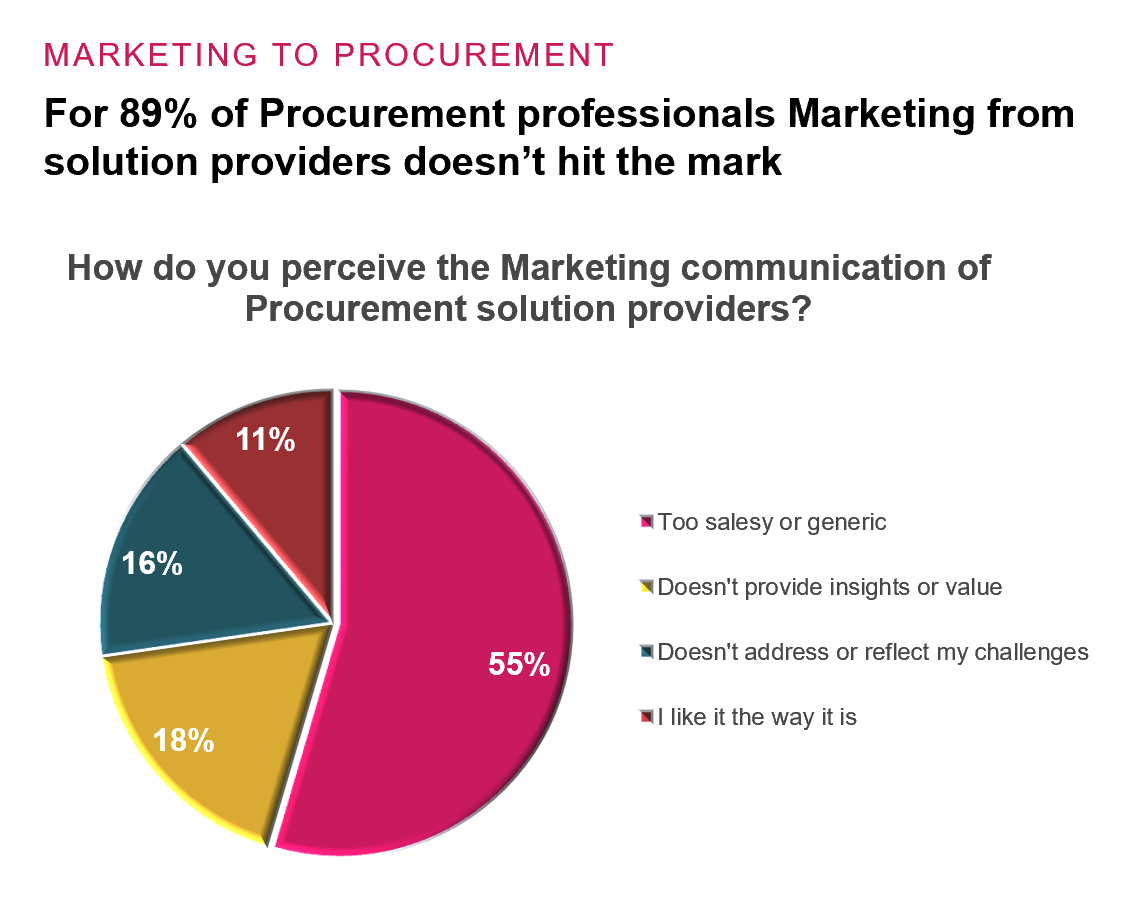5 ways to improve your marketing to Procurement professionals
A quick survey among procurement professionals revealed a huge dilemma for solution providers. 89% of procurement professionals don’t feel that current B2B marketing efforts benefit them. This is a massive challenge in the age of information, where meaningful content is the most valuable currency. Only 11% feel satisfied with the current state of communication materials.
Marketing materials miss their mark
54% of respondents felt that communications are too 'salesy' or generic. While this feeling is hard to overcome wherever sales meet professional corporate buyers, desk research and interviews with solution providers confirm this perspective. Generic value messages that don’t demonstrate a deeper understanding of procurement processes, requirements, pain points or vocabulary are abundant.
16% of respondents say that the messages and materials don’t address or reflect the challenges felt by the individual. Building on the above, a lack of understanding of individual procurement activities and how they are linked across the end-to-end procurement process makes it difficult to be specific about the pain points addressed by solution providers.
18% of procurement professionals state that communications of solution providers don’t provide deeper insight and therefore value to them. Building on the above, this makes perfect sense. With a lack of understanding of the root cause or ultimately challenge felt within a task or process, it becomes very hard to provide actionable insights or advice on how to alleviate the pain.

5 steps to improve the relevance of your communication materials
These alarming findings provide a very strong insight to solution providers as they can, partially, explain their impression of not receiving meaningful ROI from their marketing efforts. Based on our experience working with Procurement and solution providers, we found five main aspects that can help procurement solution providers improve the relevance of their marketing communications.
-
Know your audience
Procurement professionals are people with needs and wants. Understanding whom you target on a professional and emotional level will ensure that your product and messages are more aligned with the needs of your audience. -
Speak their language
Every profession has its specific vocabulary, abbreviations, and semantics. Not speaking the same language fluently will always tip people off and make them question your authority on a subject matter. Being fluent in your communications might not give you credibility but it gives you a chance to connect. -
Define your target
Trying to be everything to everybody mostly results in being nothing to nobody. Some challenges are universal, others are dependent on industries, organization sizes, or the level of organizational maturity. Make sure to map out clearly whom you are trying to reach with what message and which content piece to ensure you are relevant, not generic. -
Address their pain
People connect over a shared understanding or experience. Make sure you are specific about the pain you address, which aspect of it, and how exactly. Nothing beats “I feel you” when it comes to building connections and rapport. -
Provide added value
Procurement professionals are hungry for improving themselves, their category, and their organization. Internal training is a limited resource and often not a priority for organizations. Money for external training is even harder to get by. Fill the void with deep insights and ways for your audience to learn something new. They will love you for it.
Advance Procurement connects procurement professionals and solution providers. Based on a deep hands-on experience and understanding of Procurement we help solution providers position and communicate their offerings in a way that connects real value offerings to real pain. Reach out to discuss improving your communications and becoming a trusted source for insights and best practices.

 By
By


